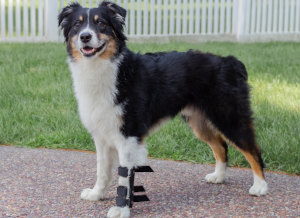- May 18, 2023
What is the Correct Front Splint for My Dog?
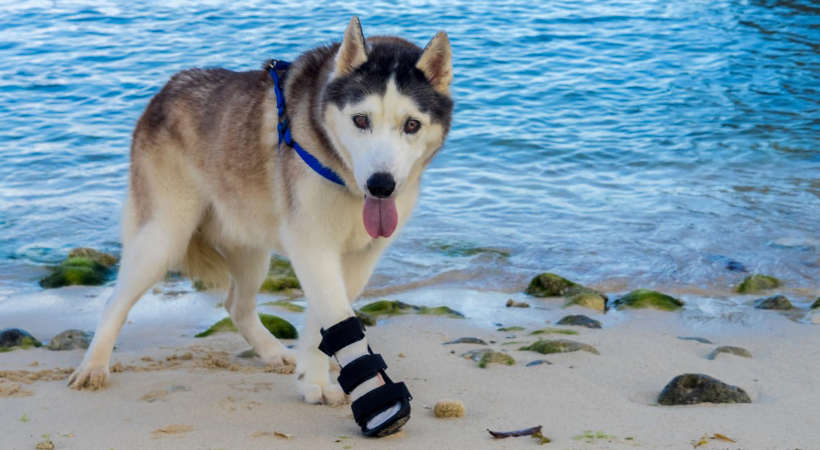
Seeing your beloved family pet start to limp or show signs of being in pain is stressful. It’s time to go to your veterinarian if you notice your dog is favoring one of its front paws over the other or is lamely lifting one of its front paws. There can be many causes for your dog limping on its front paws. A proper diagnosis will assist you in determining the following steps to help heal them.
Choosing the Right Front Splint
After your Vet has told you the root cause of your dog’s front paw weakness, you will be better prepared to find the right splint for your pup’s injury. Depending on your dog’s issue, your vet or rehab specialist will advise you on different options and potential medical equipment to assist them in treatment. Like rear paws, there are many other options for support for your dog’s front paws and even further up on the leg. Once you have been told where your dog’s pain stems from, you can get the brace or splint best suited to their needs.
What You Need to Know:
Before you purchase a canine splint, there are a few questions you need to know the answers to!
- Where is my dog’s front leg injury?
- What joint needs to be supported?
- Does my dog’s front paw need to be supported?
- How long will my dog need to wear a front leg brace?
Not sure? Always ask your veterinarian. It’s vital that your dog gets the right leg support. Choosing the right dog splint means stabilizing the correct joint to minimize your dog’s pain and to help them heal.
Bootie Splint for Front Paw and Ankle Injuries
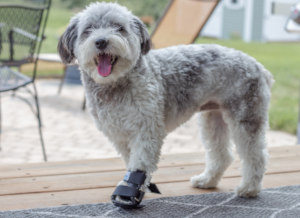
A Bootie Splint is a great option for dog’s with underlying issue causing them pain or weakness in their wrist and paw. This splint style sits much lower on the leg than other braces. A bootie splint will not go high up on the leg and just encase the foot and partially above it. This splint does not impede mobility and since it is smaller than most other leg braces it is also much lighter weight. A bootie splint is often recommended for dog’s with the following injuries:
- Toe injuries
- When the front paw requires support
- Dogs that knuckle or drag their front paws
- Wrist injuries
If your dog has a broken foot or an injury to the paw, the Bootie Splint is the best option. They are also great for dogs who have issues with knuckling or dragging as they will help to keep the paw in a proper position without infringing on the flexibility of the carpal joint.
Carpal Splint
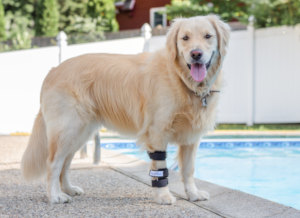
A carpal splint is the best option for dog’s front leg pain is centralized in the carpal or wrist joint and does not impact the foot. These splints allow the paw to be free but encase above and below the Carpal or wrist joint in the front leg to support and assist in stabilization.
If your dog’s issue has nothing to do with the paw, this is an excellent option as it allows full range of motion in the paw itself. This style leg brace leaves the paw free and is beneficial for dogs who do not enjoy having their paws touched, have sensory issues, or tend to be chewers. In addition, a carpal splint or tarsal brace can work with some hooved animals, like goats and sheep.
Front Splint for Lower Limb Injuries
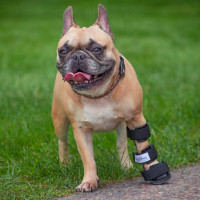
For dogs whose issue stems from the lower leg and front paw, the Front Splint is a great option. These Splints come in a large variety of sizes but make as well. For example, you can find pre-made, adjustable, and completely custom-made Front splints. Common reasons a pet me need a front splint include:
- Ligament and tendon issues
- Arthritis
- Skeletal injuries
A front splint helps to assist in healing and stabilizing a dog’s injury so that they can walk. A front splint does encase the paw in a boot and will go above the Carpal joint to stabilize the entirety of the lower leg. A full carpal splint will provide the highest level of front leg support.
Elbow Splint

Of all the splints you may need for a dog with a front leg injury, the most specialized splint they may need is an Elbow Brace. These splints are most commonly custom-made per dog to appropriately fit each dog and allow proper movement to the elbow. Some elbow injuries may need to stabilize the elbow and make it more rigid, and others make need more flexibility while providing support. Elbow braces contain a joint to allow for natural movement. Wearing an elbow brace will not impact a dog’s range of motion.
An elbow brace supports higher leg and elbow injuries. A custom made elbow brace isn’t right for every dog. Custom bracing can be costly and does take time to fabricate. A full support wheelchair may be a good alternative. The support of wheelchair reduces the weight placed on an injured front leg to make it easier for the dog to walk. Always speak to your veterinarian when deciding on the best mobility aid for your dog.
Splint Fit is Important
It’s vital that your dog’s front leg splint fits them comfortably. A properly fitted splint will hug the leg gently to safely support the front leg without rubbing or irritating your dog’s sensitive skin. Always measure your dog’s front leg before ordering a splint. Watch the video below to see the proper way to measure your dog’s front limb.
Conclusion
There are tons of different options available to you and your pet if you are looking for a front leg support brace. There are supports out there from the paw to the elbow to help you out. Understanding the benefits of each brace and what your dog’s injury will help you select the right splint for your dog. Remember, if you aren’t sure what is right for your pet, your Vet or pet medical professional should be happy to assist you in finding the best fit for your pet’s needs.
Related Articles:
Tags
What do you think?
Related Articles

New Puppy Checklist: Gear You’ll Need for Your New Dog
Getting a new puppy is really exciting, but before you welcome them home, it’s important to prepare your space for them. Since puppies need a

How Big Do Mini Poodles Get? Vet Reviewed Average Weight & Growth Chart – Dogster
The information is current and up-to-date in accordance with the latest veterinarian research. Learn more » When you buy a Miniature Poodle, you might not

Can Police Dogs Smell Nicotine? Vet Verified Facts & Info – Dogster
The information is current and up-to-date in accordance with the latest veterinarian research. Learn more » While cigarette sales have been declining steadily for decades,

How Old Is 5 in Dog Years? Vet-Approved Guide to Each Size of Dog – Dogster
The information is current and up-to-date in accordance with the latest veterinarian research. Learn more » A common method for calculating a dog’s age is



